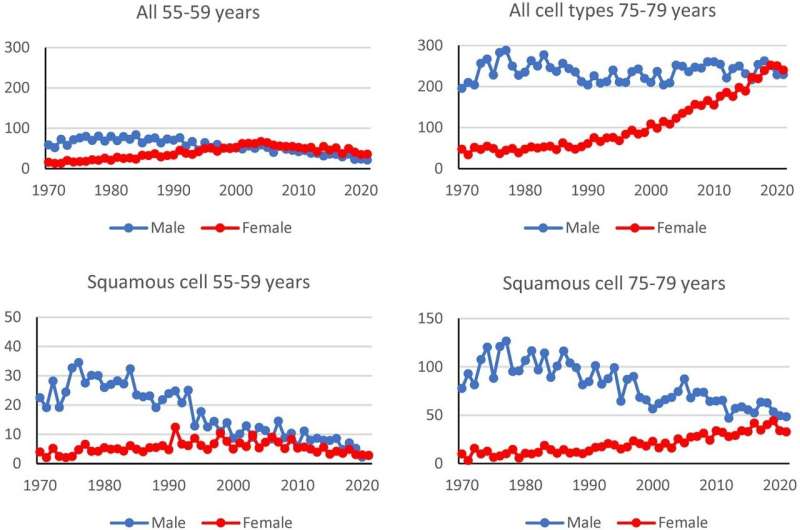This article has been reviewed according to Science X's editorial process and policies. Editors have highlighted the following attributes while ensuring the content's credibility:
fact-checked
peer-reviewed publication
trusted source
proofread
Study suggests lung cancer does not decrease in line with reduced smoking

Despite the fact that the number of people who smoke has decreased very sharply in Sweden, the number of cases of lung cancer in the population is not decreasing as much as expected. Among women, lung cancer has, in fact, increased. This is shown in a new study published in European Journal of Public Health from Umeå University, Sweden. The study means that the view of how long smoking affects health may change.
"Smoking is undoubtedly the most important risk factor for lung cancer. It is therefore surprising that the decline in smoking is not yet more visible in the statistics. More research is needed to find out why this is the case," says Bengt Järvholm, professor at the Department of Public Health and Clinical Medicine at Umeå University.
The number of people who smoke has been declining in Sweden for many years. Today, 1 in 20 Swedes, about 5%, among men and women state that they smoke daily. In the 1960s, about 1 in 2 Swedish men between the ages of 18 and 69 smoked.
Women generally started smoking later in history than men. In a large study in 1963, only slightly more than 1 in 10 women, 11%, aged 50–69 smoked, while 46% of men were smokers. Among women, it was mainly younger people who smoked in the 1960s.
According to previous research, the risk of developing lung cancer decreases sharply and quickly after quitting smoking. According to a British study, the number of people who had lung cancer before the age of 75 fell from 16% to 3% among those who quit smoking before the age of 50.
The Umeå researchers have compared the change in smoking habits in Sweden from the 1950s with the incidence of lung cancer between 1970 and 2021 in men and women aged 40–84 years. They studied how the risk varied among men and women in different age groups. Previous studies have shown that squamous cell cancer is the form of lung cancer that has the strongest association with smoking.
The results showed that the risk of being affected varied greatly depending on the type of lung cancer, age and gender. Based on previous studies, it would have been expected that the risk of cancer would have decreased among the elderly, as well. However, lung cancer was as common in 1970 as in 2021 among men aged 75–79 years. The number of squamous cell cancer had fallen sharply, while in 2021 it had instead increased six-fold for the other common form of cancer, adenocarcinoma.
The risk of squamous cell cancer had increased among women in the age group 75–79 years to the same level as among men. For adenocarcinoma, the risk was similar for women and men, despite the fact that there were large differences in smoking habits among women and men in the 1970s.
The study does not provide an answer as to why the development of lung cancer does not correspond well with expectations. For that, other types of studies are required. However, there are several possible explanations. One explanation may be that people may underreport their smoking, i.e., that the reduction in smoking may be smaller in reality.
Another possible explanation may be that previous assumptions have been exaggerated about how quickly the risk of being affected decreases when you quit smoking. Nor can it be ruled out that other environmental or lifestyle factors may play a role; even those who have never smoked can get lung cancer, although it is less common.
The fact that the trend is so much worse for women than for men is due to the fact that Swedish women generally started smoking later in history than men.
"The results should certainly not be interpreted as it is useless to quit smoking. On the contrary, the study emphasizes the importance of quitting early, preferably never starting, as it may be the case that the risk of lung cancer is elevated for longer than we previously thought," says Bengt Järvholm.
The study shows that if the risk of developing lung cancer in 2021 was as high as the risk in 1970 in men and women aged 40–84, approximately 2,250 men would have suffered from lung cancer in 2021 instead of 1,695 cases, i.e., a decrease of 555 cases. Among women, there would have been 544 cases instead of the current 2,181 cases, i.e., there has been an increase of 1,637 cases of lung cancer.
The study is based on data from the National Board of Health and Welfare's cancer registry, which was compared with statistics on tobacco smoking from surveys and from the sale of cigarettes.
More information: Bengt Järvholm et al, Changing smoking habits and the occurrence of lung cancer in Sweden—a population analysis, European Journal of Public Health (2024). DOI: 10.1093/eurpub/ckae050




















